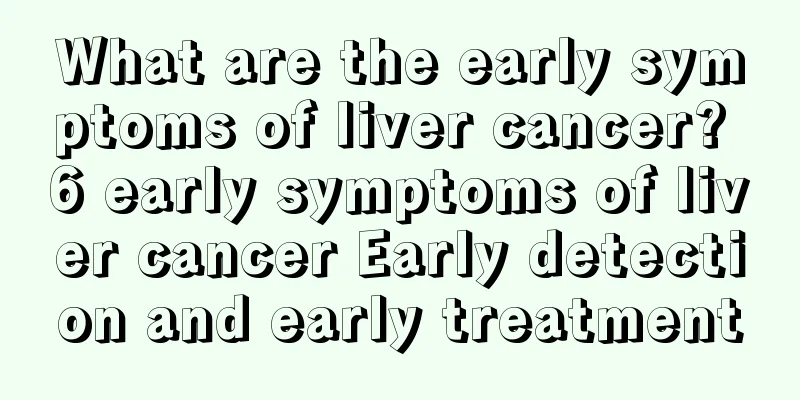What are the early symptoms of liver cancer? 6 early symptoms of liver cancer Early detection and early treatment

|
We all know that liver cancer is a malignant tumor. If it is not treated in time in the early stages, it will cause great harm to the patient. However, once liver cancer is diagnosed, it is basically in the middle or late stages. This is directly related to the atypical early symptoms of liver cancer. The following experts will introduce to you the common early symptoms of liver cancer. 1. Significant decrease in appetite: abdominal distension, indigestion, and sometimes nausea and vomiting. 2. Liver pain: In the early stage of liver cancer, patients may experience liver pain. This is because the liver area may have persistent or intermittent pain, which may be aggravated by changes in body position. It may radiate to the back or right shoulder. In the late stage of liver cancer, severe abdominal pain and peritoneal irritation may suddenly occur. This may be due to necrosis of the tumor nodules or bleeding into the abdominal cavity. At this time, patients often go to the emergency room for treatment with acute abdomen. 3. Jaundice and ascites: Again, the symptoms of liver cancer may include jaundice, ascites and a series of other symptoms. Skin itching: It is a common symptom of liver cancer. About 1/3 of the cases have jaundice during the course of the disease. The cause of jaundice is that the tumor invades the main bile duct in the liver, and the metastatic cancer of the portal lymph nodes compresses the extrahepatic bile duct. Ascites is often caused by the patient's original liver cirrhosis, the invasion of cancer tissue into the vein to form a cancer thrombus, and the compression of the portal vein by cancer nodules. Ascites often accumulates very quickly and can be straw yellow or bloody. Skin itching is a common symptom of patients with liver disease and liver cancer. 4. Bleeding: Early symptoms of liver cancer may include bleeding. This is because patients often experience nosebleeds and subcutaneous bleeding, which are mostly caused by liver tissue damage and liver failure. Portal hypertension can cause esophageal and gastric varicose vein rupture and bleeding. When cancerous tissue invades the bile duct at the liver portal, it can cause bile duct bleeding. 5. Systemic failure: severe fatigue, weight loss, progressive anemia and edema. 6. Hepatomegaly, splenomegaly, and fever: 90% of liver cancers have hepatomegaly. The enlarged liver is often hard and irregular in appearance, with nodules of varying sizes on the edges. Giant liver cancer can sometimes deform the liver, making it difficult to identify during palpation. |
Recommend
Can B-ultrasound detect bladder tumors?
Physical health is very important for people nowa...
What are the nursing methods for liver cancer bedsores? The most comprehensive introduction to nursing methods for liver cancer bedsores
Liver cancer patients are bedridden for a long ti...
Xuanyang Decoction plus Jiyin Decoction for the treatment of bladder cancer
Bladder cancer belongs to the category of "u...
The best age to learn painting
With the development of the economy, people have ...
How to clean the toilet with vinegar
The toilet at home should be cleaned regularly. I...
What is the color of bile
Bile is a substance secreted by the human liver a...
How to better classify bone cancer
How is bone cancer classified? Cancer is familiar...
Ten major symptoms of early clinical manifestations of nasopharyngeal carcinoma
Nasopharyngeal carcinoma refers to a malignant tu...
Oven baked dried squid
Squid is something we often eat, and there are va...
What is causing my lower back pain and weak legs?
Lower back pain and weak legs are common symptoms...
Does drinking brown sugar water have any effect on eye inflammation?
Eye inflammation is a disease that has a relative...
Which symptoms indicate the occurrence of liver cancer? These symptoms indicate liver cancer disease
Liver cancer is a common disease in life, but mos...
How to care for liver cancer patients in daily life? Several methods of caring for liver cancer patients
People with liver cancer are generally in a low m...
Where is the best place to treat endometrial cancer
Endometrial cancer is a common disease. This dise...
Can't people with thyroid cancer drink celery juice?
Clinically, there is no saying that thyroid cance...









